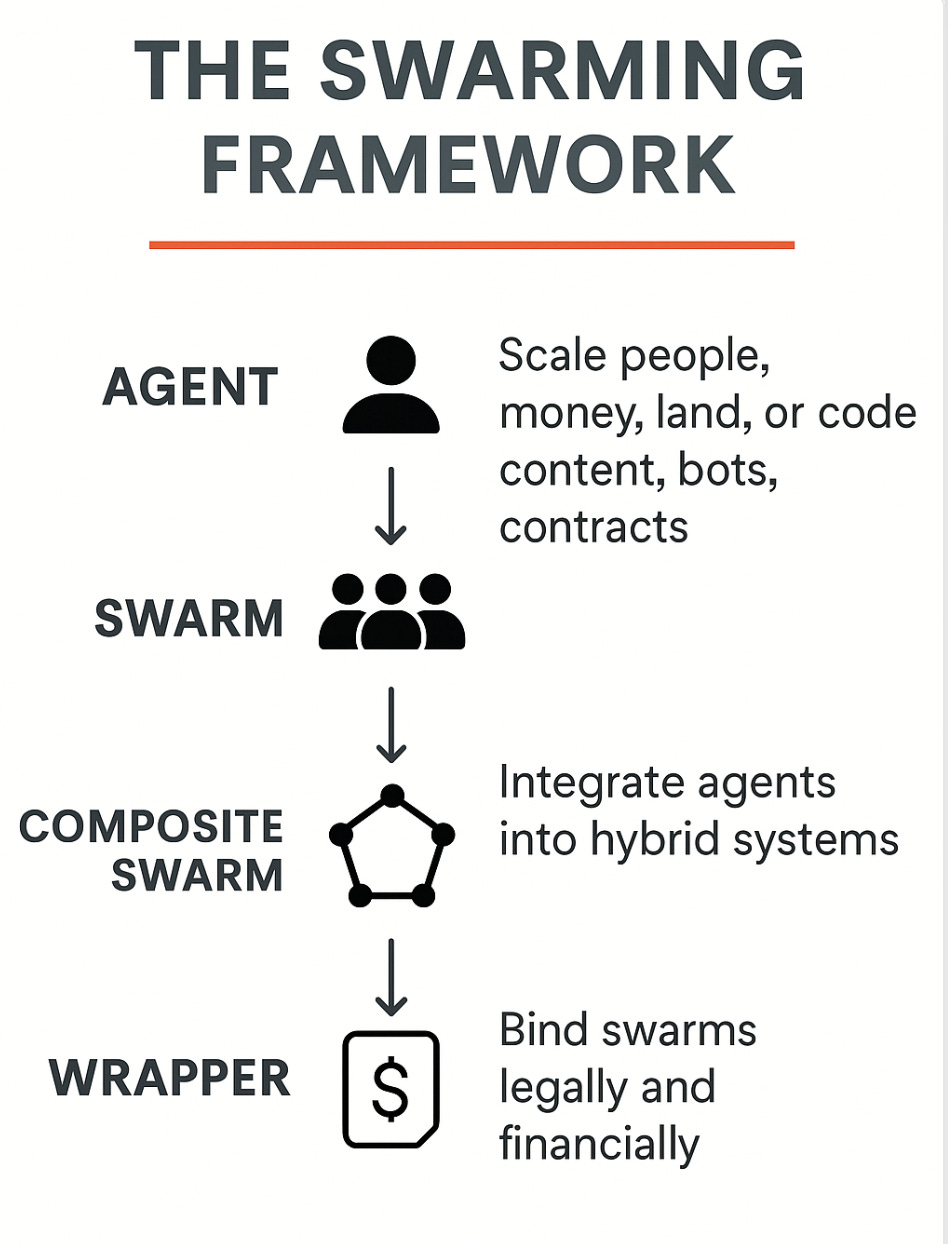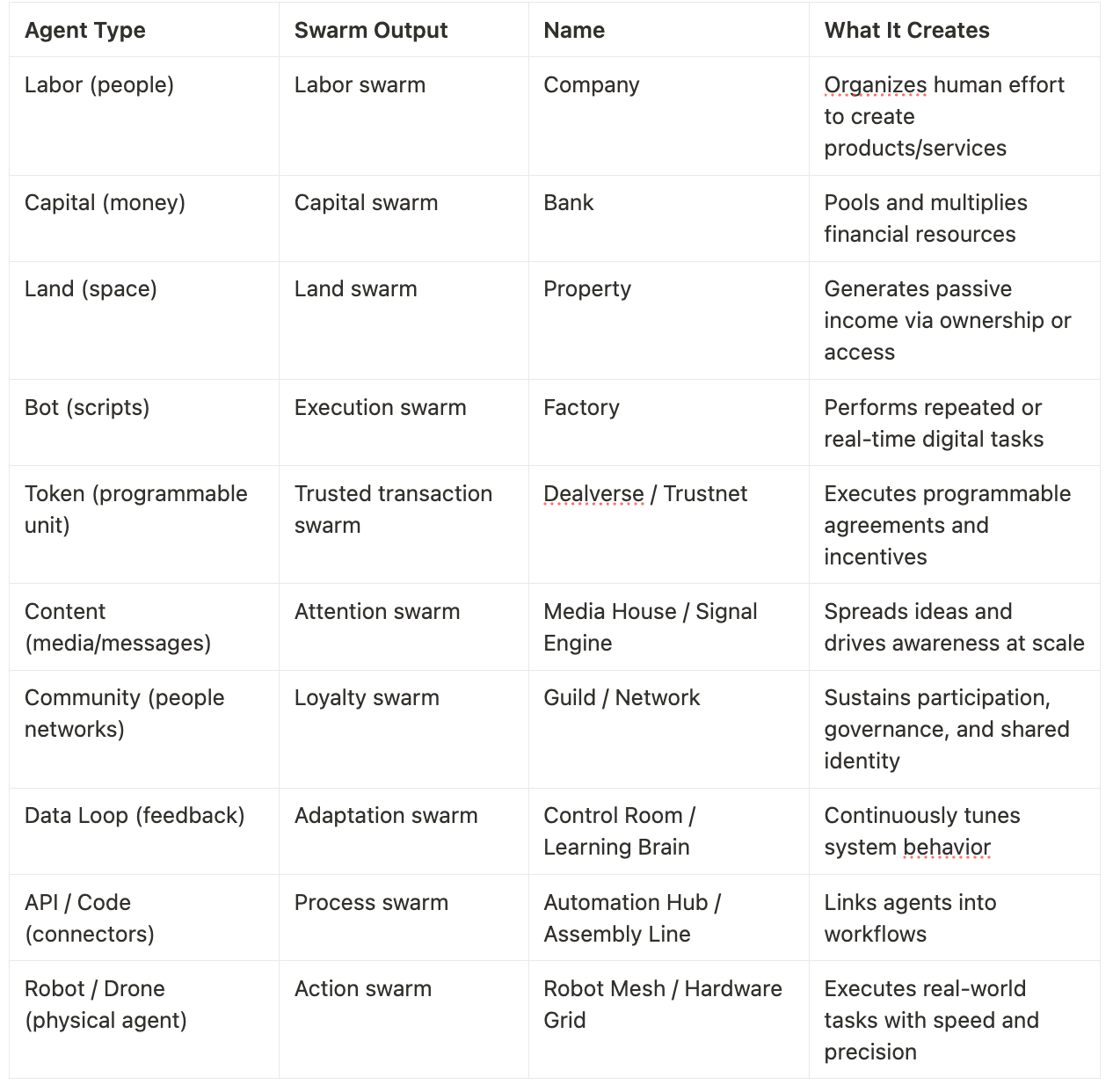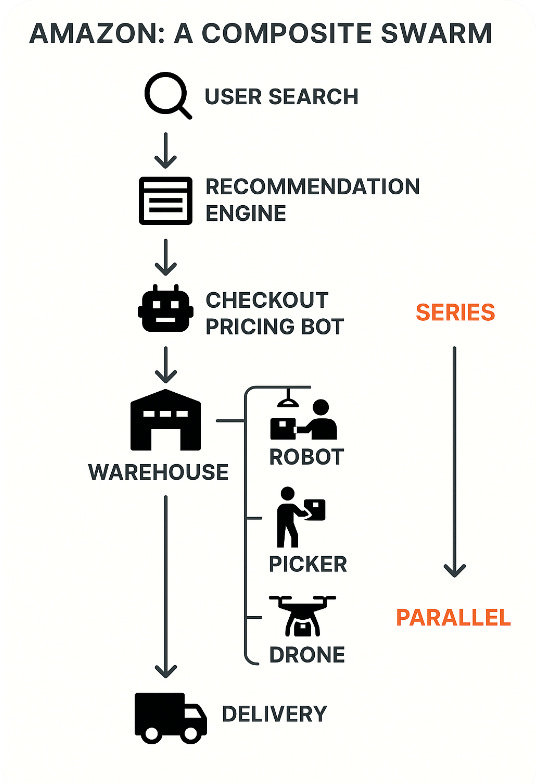Don’t Build a Company. Build a Swarm. [The Swarming Framework]
A new blueprint for scaling work, value, and intelligence through AI agents, bots, and smart systems — that swarm around you, run 24/7, and connect directly to your bank account.
For solopreneurs, creators, builders, and anyone tired of scaling with headcount.
The Core Insight
We live in a world obsessed with scale. But most people still try to scale themselves — their time, their team, their hustle.
What if you could scale something else? What if you could scale your agents?
Human effort is finite. You can be the smartest person, but there is only so much you can do by yourself - there is just one of you and only 24 hours in a day.
In every era, leverage has come from scaling agents — things that create value without constant supervision:
In the agricultural age: Land
In the industrial age: Labor
In the capitalist age: Capital
In the information age: Code, content, and networks
And now, in the AI age: Bots. Tokens. Autonomous systems.
This is the secret of building wealth and scale - autonomous things that duplicate themselves without constant input from you, and work to multiply even when you sleep.
Now, these agents don’t work alone anymore — they move together, in swarms - And that changes everything.
The Ladder of Understanding: Agent → Swarm → Composite Swarm → Wrapper
1. Agent
An agent is any unit that produces value — repeatedly, autonomously, and with minimal supervision. Agents can be physical (like drones), digital (like bots or APIs), or logical (like feedback loops).
We’ve always used agents to scale — farmhands, clerks, capital. Today, agents are programmable, self-replicating, and distributed.
Think of them as the atomic units of modern leverage. One agent can perform a task. A swarm of agents can build an economy.
Here’s how different agent types evolve into scalable systems:
2. Swarm
A swarm is what happens when multiple agents work together — in series, parallel, or both.
Series: A chain of tasks (e.g., input → process → output)
Parallel: Many agents acting simultaneously (e.g., multiple bots posting variations)
Hybrid: Where structured flows meet autonomous agents at scale - a combination of many different types of agents combining in circuits which are a mix of series and parallel
Swarming is not chaos. It’s coordination at machine speed. A good swarm runs continuously, learns as it goes, and scales without adding human bandwidth.
3. Composite Swarm
When different agent types integrate in any order — bots, APIs, tokens, data loops, communities — you get a composite swarm: a system that can plan, act, adapt, and evolve.
Examples:
Telegram
Amazon
Open source AI ecosystems
Autonomous marketplaces
Composite swarms are like living digital organisms. They don’t scale like companies. They scale like networks.
When you buy something as simple as a phone case on Amazon, you’re activating a swarm. Dozens of agents — bots, APIs, warehouse robots, pricing engines, community reviews, and even drones — coordinate across time and space. Some work in series (payment, order routing, delivery), while others operate in parallel (recommendation, reviews, pricing, content). From the second you search, autonomous systems personalize your results, optimize for your location, route your order, pick, pack, label, and ship — often without a single person touching the process. It feels like one-click magic, but underneath, Amazon is a composite swarm: a living, self-improving system made of agents — each one learning, reacting, and scaling without headcount. That’s not a company. That’s a swarm with a wrapper.
4. Wrapper
A wrapper gives a swarm structure and identity — legally, financially, and operationally.
Yesterday: Corporations, LLCs
Today: Everything above, plus Telegram bots, Discord servers, Substack pages, DAOs
Tomorrow: Protocol-native firms, wallet-based businesses, self-executing legal shells
The swarm is the engine. The wrapper is the interface.
Telegram: A Swarming Business
Telegram didn’t scale with headcount. It scaled with agents.
Bots run payments, games, support, automation
Content is created and distributed by users, not employees
Communities self-organize in channels and supergroups
Developers extend the platform without approval
Feedback loops drive product evolution
Tokens (TON) power monetization and commerce
APIs connect it all — millions of bots live on Telegram
It runs on fewer than 100 people. It serves over 1 billion users.
It generates over $1 billion in revenue.
That’s not a traditional company. That’s a swarm business.
The secret of scale isn’t just speed — it’s structure.
From The Exponential Growth Framework, exponential systems are built on three foundations:
Fast iteration — short feedback loops that compound
Leverage per input — small actions that create large outcomes
Self-improvement — systems that learn and evolve on their own
Swarms are built for exactly this.
They don’t just run faster. They get better with every loop.
They scale without requiring you to scale yourself.
A good swarm doesn’t grow by force. It grows by replication, learning, and emergence.
They’re always running. They improve through interaction. They don’t need more people to grow.
But swarms also break if:
Agents degrade or go stale
Feedback is noisy or missing
Trust collapses
Wrappers fail (e.g., platform bans, legal issues)
To survive, swarms must evolve like organisms — with mutation, redundancy, feedback, and adaptability.
Swarms Anyone Can Build:
You don’t need a team. Or VC money. Or special permission.
If you’ve used WhatsApp, built a Notion board, or posted to LinkedIn — you can build a swarm.
Here are four swarms you can launch today:
1. Build a Music Swarm — Let the Songs Spread Themselves
🎯 For independent musicians, producers, and creators who want to reach millions — without managers, labels, or social media fatigue.
Create remixes or original music, tag metadata, distribute across platforms, pitch to playlists, and reward fans — automatically.
Use a swarm to create a 1000 virtual bands, all of whom create 2 albums of 15 tracks = 30,000 tracks per year, upload to all streaming platforms like Apple Music and Spotify, Use an automated as conversion engine to boost the tracks with traction = 30000 tracks x 5000 streams/track (20000 streams for top 20% and 1000 for bottom 80%) x $0.0055 per stream = $825K in the bank, with about $500K profit.
Tools: Suno, Udio, GPT-4, Airtable, Zapier, Distrokid
Swarm Type: Music Factory + Media Platform
Start with: one track, one remix, one upload loop
2. Build a Feedback Swarm — Make Every Product Listen and Pay
🎯 For D2C founders, product managers, and e-commerce marketers who want real-time insight and retention — without surveys or support tickets.
Transform QR codes on product packaging into live feedback, paid users, and recurring B2B revenue.
Let’s say you target 500 SKUs across 30 D2C brands. Assume each SKU sells 20,000 units per year → that’s 10 million products shipped.
You achieve a 3% scan rate → 300,000 feedback loops triggered.
Each response earns $0.10 per user from the brand → $30,000 payout to users.
You charge brands $0.50 per response → $150,000 in revenue.
Do this across 7 categories → $1M+ annual revenue.
What it does:
QR on product → bot starts chat
GPT summarizes feedback instantly
User gets a reward token, discount, or cashback
Brands see structured dashboards + highlights
Feedback improves product, and future response rates
Tools: QR code + packaging print, WhatsApp bot (WATI or Twilio), GPT-4 or Claude, Notion/Airtable, Zapier, Stripe/TON
Swarm Type: Trustnet + Learning Brain
Start with: 1 SKU, 1 bot, and 1 D2C founder friend willing to test
3. Build a Job Swarm — Get 10,000 People to Pay You $100/Year
🎯 For job market insiders, creators, or career mentors who want to monetize job access, not job listings.
Replace job boards and job hunts with a swarm that delivers opportunities — personalized, ongoing, and intelligent.
Let’s say you acquire 10,000 users paying $100/year for a subscription to job discovery, auto-application, and GPT-enhanced CVs → $1M in annual revenue.
Additionally, for the top 20% of placements, employers pay a $500 fee. If 2,000 users get hired and 20% trigger a commission = 400 × $500 = $200,000 bonus.
Total potential:
$1M from subscriptions
$200K from employer commissions
All handled by bots
What it does:
Finds jobs in real time across industries
Tokenizes them by skill, location, pay, format
GPT matches jobs to user profiles
GPT rewrites CV and cover letter
One-click apply, tracked automatically
User gets weekly personalized job drops, status alerts, and tips
Tools: Browse AI or Apify, OpenAI GPT-4, Glide or Notion, Stripe, Zapier
Swarm Type: Dealverse + Automation Engine
Start with: a niche market — ex-founders looking for remote ops roles, for example
4. Build a Teaching Swarm — Turn GPT into a Scalable School That Pays You
🎯 For teachers, tutors, YouTubers, or subject-matter experts who want to teach 1,000s — without Zoom, classrooms, or burnout.
Launch a network of bots that teach key subjects via chat — then charge students to access the best ones.
Each bot teaches one subject (e.g., Algebra I, Physics, Python). Assume you create 20 subject bots. Each bot gets 500 paying users at $10/month/subject =
20 × 500 × $10 × 12 months = $1.2M/year
Build once. Let the bots teach forever.
Where does the bot get the content from?
You can pull structured lesson flows from:
Open curriculum repositories (e.g., Khan Academy, CK-12, MIT OCW)
YouTube transcripts of top educators
Textbooks or AI-generated summaries
Your own notes (if you’re an expert or hire a freelancer)
Use GPT to turn these into:
Step-by-step explanations
Quizzes
Diagrams (with image generators or video)
Practice problems and adaptive walkthroughs
What it does:
Assesses where the student is stuck
Teaches via story, analogy, step-by-step logic
Quizzes and checks understanding
Rewards progress with badges, tokens, or streaks
Enables peer challenge + leaderboard
Tools: GPT-4, Typeform or Tally, Notion for progress tracking, Stripe, Telegram or WhatsApp bots
Swarm Type: Learning System + Guild
Start with: 1 subject, 1 student segment, 1 Telegram bot
A Note Before You Start:
Each of these begins the same way:
One workflow
One agent
One feedback loop
You build from there.
Start where you are. Scale as you learn. Let the swarm grow around you.
Starting To Build Your Swarm Inside Your Organisation:
In addition to creating these new models, you can also use swarms within your existing company or workflows to totally transform your productivity and effectiveness.
Spot agents — What do you do repeatedly that an agent could handle?
Break the workflow — Map your task in series or parallel steps
Use the AI Implementation Pyramid to define the workflows that will be automated using some sort of bot:
Add feedback — Loop performance into the next iteration
Wrap it — Telegram bot, Discord server, Substack, DAO
Connect to money — Stripe, TON, crypto wallets, Gnosis Safe
From Companies to Swarms:
In the industrial age:
Swarm of labor → Company
Swarm of capital → Bank
Swarm of land → Property
In the AI age:
Swarm of bots → Factory
Swarm of tokens → Trustnet
Swarm of content → Media platform
Swarm of community → Guild
Swarm of feedback → Learning brain
Swarm of APIs → Automation engine
Swarm of swarms → Composite swarm
You wrap it. You connect it to money. And let it fly.
Because today, you don’t just build apps. You build swarms.
#FastFrameworks #SwarmingFramework #BuildSwarmsNotCompanies #AIArchitecture #AgentEconomy #CompositeSwarms #WrapperEconomy #AIWorkflows #BotEconomy #AutomationFirst #GPTBots #AIProductivity #LLMAgents #ScaleWithoutHeadcount #DigitalInfrastructure #StartupStack #ModernBusinessDesign #NetworkedGrowth #TokenEconomy #IntelligentRevenue #PassiveScale #AIRevenueStreams #NoCodeMonetization
If you found this post valuable, please share it with your networks.
In case you would like me to share a framework for a specific issue which is not covered here, or if you would like to share a framework of your own with the community, please comment below or send me a message
Check out some of my other Frameworks on the Fast Frameworks Substack:
The Promotion Flywheel Framework
The Immortality Stack Framework
Frameworks for business growth
The AI implementation pyramid framework for business
A New Year Wish: eBook with consolidated Frameworks for Fulfilment
AI Giveaways Series Part 4: Meet Your AI Lawyer. Draft a contract in under a minute.
AI Giveaways Series Part 3: Create Sophisticated Presentations in Under 2 Minutes
AI Giveaways Series Part 2: Create Compelling Visuals from Text in 30 Seconds
AI Giveaways Series Part 1: Build a Website for Free in 90 Seconds
Business organisation frameworks
The delayed gratification framework for intelligent investing
The Fast Frameworks eBook+ Podcast: High-Impact Negotiation Frameworks Part 2-5
The Fast Frameworks eBook+ Podcast: High-Impact Negotiation Frameworks Part 1
Fast Frameworks: A.I. Tools - NotebookLM
The triple filter speech framework
High-Impact Negotiation Frameworks: 5/5 - pressure and unethical tactics
High-impact negotiation frameworks 4/5 - end-stage tactics
High-impact negotiation frameworks 3/5 - middle-stage tactics
High-impact negotiation frameworks 2/5 - early-stage tactics
High-impact negotiation frameworks 1/5 - Negotiating principles
Milestone 53 - reflections on completing 66% of the journey
The exponential growth framework
Fast Frameworks: A.I. Tools - Chatbots
Video: A.I. Frameworks by Aditya Sehgal
The job satisfaction framework
Fast Frameworks - A.I. Tools - Suno.AI
The Set Point Framework for Habit Change
The Plants Vs Buildings Framework
Spatial computing - a game changer with the Vision Pro
The 'magic' Framework for unfair advantage





